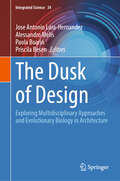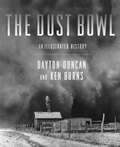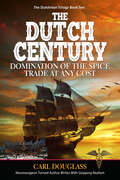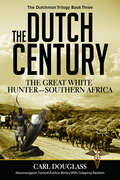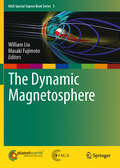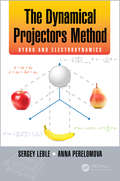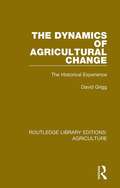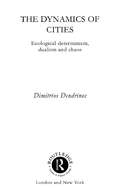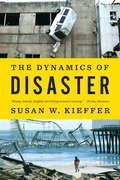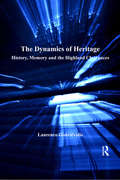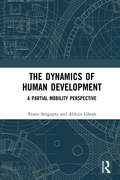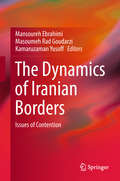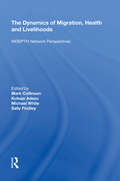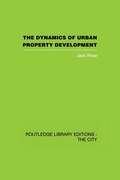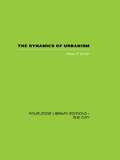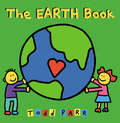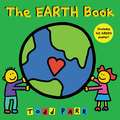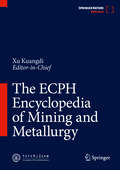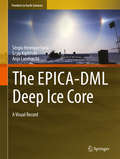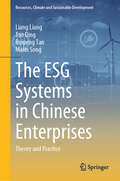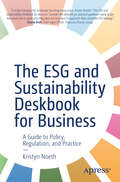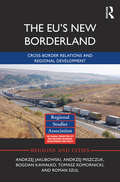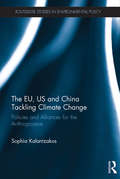- Table View
- List View
The Dusk of Design: Exploring Multidisciplinary Approaches and Evolutionary Biology in Architecture (Integrated Science #34)
by Alessandro Melis Jose Antonio Lara-Hernandez Paola Boarin Priscila BesenThe Dusk of Design explores the intersection of evolutionary theories and architectural design. Drawing inspiration from the concept of exaptation in biology, the book argues that natural selection, as the most successful designer on our planet, thrives on the diversity, variability, and redundancy of creative structures. By transferring these mechanisms to architectural design, the book contends that we can cultivate more resilient and sustainable architecture and cities in the face of environmental crises.This book seeks to illuminate the profound potential of multidisciplinarity by examining case studies from architecture worldwide. By exploring how evolutionary theories can explain various architectural phenomena, it aims to inspire architects, designers, researchers, and students to adopt a holistic and transdisciplinary approach to their work.The book provides a clear and concise overview of evolutionary principles, demonstrating their relevance to architecture.It will showcase a range of case studies that highlight the application of evolutionary theories in solving architectural challenges, such as adaptive reuse, sustainable urban planning, and resilient design in the face of climate change.Ultimately, "The Dusk of Design" aims to bridge the gap between biology and architecture, presenting a fresh perspective on how we can create more innovative, sustainable, and resilient built environments.
The Dust Bowl
by Molly Smith Elaina JacobsDuring the 1930s, the Great Plains region of the United States earned the nickname "the Dust Bowl" because of the many large dust storms that raged across the open land there. Learn more about these "black blizzards" and their devastating effects.
The Dust Bowl: An Illustrated History
by Ken Burns Dayton DuncanThis “riveting” companion to the PBS documentary “clarifies our understanding of the ‘worst manmade ecological disaster in American history’” (Booklist).In this riveting chronicle, Dayton Duncan and Ken Burns capture the profound drama of the American Dust Bowl of the 1930s. Terrifying photographs of mile-high dust storms, along with firsthand accounts by more than two dozen eyewitnesses, bring to life this heart-wrenching catastrophe, when a combination of drought, wind, and poor farming practices turned millions of acres of the Great Plains into a wasteland, killing crops and livestock, threatening the lives of small children, burying homesteaders’ hopes under huge dunes of dirt—and setting in motion a mass migration the likes of which the nation had never seen. Burns and Duncan collected more than three hundred mesmerizing photographs, some never before published, scoured private letters, government reports, and newspaper articles, and conducted in-depth interviews to produce a document that may likely be the last recorded testimony of the generation who lived through this defining decade.
The Dutch Century: Domination of the Spice Trade at Any Cost (The\dutchman Trilogy Ser. #Vol. 1)
by Carl DouglassThe Dutch Century: Domination of the Spice Trade at Any Cost is the second of three books about the remarkable 17th century, primarily owned by the Netherlands. It reveals--as historical fiction—the adventures, trials, risks, accomplishments, conflicts, atrocities, and crimes, of the Dutch and specifically of the Seagoing Van Brakel family.
The Dutch Century: The Great White Hunter—Southern Africa
by Carl DouglassThe Great White Hunter—Southern Africa is the third and final book of the Dutch Century Trilogy. It covers the last two-thirds of the 1600s, during which the Dutch exercised considerable control of all sub-Saharan Africa. Among the Dutch who spent significant portions of their lives in the region were farmers, traders, builders, mariners, and slavers. And, most interesting, some intrepid long-distance hunters. They sought fortunes as rewards for museum-quality mounted specimens, success beyond their wildest imaginations from the elephant tusk/ivory trade, and adventure—always adventure. They were brave and hardy souls who faced hardships of miserable travel in oxwaggons, difficult to manage native helpers, balky oxen, mules, and horses. In addition, there were problems of tribalism, close calls from fearsome beasts, including lions, leopards, elephants, rhinos, crocs, and dangerous men. Piet van Brakel explored the lower half of the African continent while still a fugitive from the dangerous Dutch VOC. To succeed, he had to control the vicissitudes of weather—floods, droughts, winds, starvation, and great thirsts. He was the baas, the bwana who had to deal with all unseen and unknown surprises. That included: animal attacks, Arab slaver/killer invasion, war with ruthless Zulu impis, poisons, malfunctioning guns, and misbehaving men of his safari team. He lost six of his nine lives, accumulated hard-won treasure twice, and gained incomparable friends and success beyond measure. Such a life was never a sure thing for the man. How he accomplished, that is the stuff of legend.
The Dynamic Magnetosphere
by William Liu Masaki FujimotoDespite the plethora of monographs published in recent years, few cover recent progress in magnetospheric physics in broad areas of research. While a topical focus is important to in-depth views at a problem, a broad overview of our field is also needed. The volume answers to the latter need. With the collection of articles written by leading scientists, the contributions contained in the book describe latest research results in solar wind-magnetosphere interaction, magnetospheric substorms, magnetosphere-ionosphere coupling, transport phenomena in the plasma sheet, wave and particle dynamics in the ring current and radiation belts, and extra-terrestrial magnetospheric systems. In addition to its breadth and timeliness, the book highlights innovative methods and techniques to study the geospace.
The Dynamical Projectors Method: Hydro and Electrodynamics
by Sergey Leble Anna PerelomovaThe dynamical projectors method proves to reduce a multicomponent problem to the simplest one-component problem with its solution determined by specific initial or boundary conditions. Its universality and application in many different physical problems make it particularly useful in hydrodynamics, electrodynamics, plasma physics, and boundary layer problems. A great variety of underlying mechanisms are included making this book useful for those working in wave theory, hydrodynamics, electromagnetism, and applications. "The authors developed a universal and elegant tool – dynamical projector method. Using this method for very complicated hydro-thermodynamic and electrodynamics problem settings, they were able to get a lot of interesting analytical results in areas where before often just numerical methods were applicable." —L. A. Bordag, University of Applied Sciences Zittau/Görlitz, Zittau, Germany "The book is intended for professionals working in various fields of linear and nonlinear mathematical physics, partial differential equations and theoretical physics. The book is written clearly, and in my opinion, its material will be useful and easy to understand for professionals and for students familiar with ordinary and partial differential equations." —Sergey Dobrokhotov, Russian Academy of Sciences, Moscow, Russia
The Dynamics of Agricultural Change: The Historical Experience (Routledge Library Editions: Agriculture #10)
by David GriggFirst published in 1982. Until the nineteenth-century the history of agriculture was the history of mankind but it has not perhaps received the wide attention that this importance justifies. In this study, the author reviews for the student of agricultural history successive attempts to describe and explain agricultural changes that are not specific to a limited area or a particular time. In a sense The Dynamics of Agricultural Change is a systematic historical geography of agriculture. Some of the models the author explores have been developed within agricultural history; some, drawn from other disciplines, can be applied fruitfully to it. What is the relationship between population growth and agricultural development? Between environmental changes and those in agriculture? What was the effect of the industrial revolution? And has there been an agricultural revolution? This book suggests to university students of economic history, historical geography and agriculture, a number of stimulating ways of interpreting and reinterpreting agricultural history.
The Dynamics of Cities: Ecological Determinism, Dualism and Chaos
by Dimitrios DendrinosDimitrios Dendrinos, an expert in the application of non-linear dynamics and chaos theory to the subject of urban and regional dynamics, focuses here on fundamental issues in population growth and decline. He approaches the topic of urban growth and decline within a global system perspective, viewing the rise and fall of cities, industries and nations as the result of global interdependencies which lead to unstable dynamics and widespread dualisms. Professor Dendrinos provides valuable insights into the evolution of human settlements and considers the possible futures open to the giant cities of the world.
The Dynamics of Disaster
by Susan W. Kieffer"If you are an amateur weather geek, disaster wonk, or budding student of earth sciences, you will want to read this book."--Seattle Times In 2011, there were fourteen natural calamities that each destroyed over a billion dollars' worth of property in the United States alone. In 2012, Hurricane Sandy ravaged the East Coast and major earthquakes struck in Italy, the Philippines, Iran, and Afghanistan. In the first half of 2013, the awful drumbeat continued--a monster supertornado struck Moore, Oklahoma; a powerful earthquake shook Sichuan, China; a cyclone ravaged Queensland, Australia; massive floods inundated Jakarta, Indonesia; and the largest wildfire ever engulfed a large part of Colorado. Despite these events, we still behave as if natural disasters are outliers. Why else would we continue to build new communities near active volcanoes, on tectonically active faults, on flood plains, and in areas routinely lashed by vicious storms? A famous historian once observed that "civilization exists by geologic consent, subject to change without notice." In the pages of this unique book, leading geologist Susan W. Kieffer provides a primer on most types of natural disasters: earthquakes, tsunamis, volcanoes, landslides, hurricanes, cyclones, and tornadoes. By taking us behind the scenes of the underlying geology that causes them, she shows why natural disasters are more common than we realize, and that their impact on us will increase as our growing population crowds us into ever more vulnerable areas. Kieffer describes how natural disasters result from "changes in state" in a geologic system, much as when water turns to steam. By understanding what causes these changes of state, we can begin to understand the dynamics of natural disasters. In the book's concluding chapter, Kieffer outlines how we might better prepare for, and in some cases prevent, future disasters. She also calls for the creation of an organization, something akin to the Centers for Disease Control and Prevention but focused on pending natural disasters.
The Dynamics of Heritage: History, Memory and the Highland Clearances (Heritage, Culture and Identity)
by Laurence GouriévidisThere has been much academic interest in the role of museums as places where understanding of the past is shaped and legitimised for a wide and increasingly diverse public. This book focuses on the museum representations of the Highland Clearances - a much neglected aspect of one of the most disputed and politically-charged issues in modern Scottish history. Drawing together a range of inter-disciplinary themes and notions, it considers the cultural legacy of the period, brings to light the socially and historically conditioned meanings and values encapsulated in museum narratives of the Clearances, and shows the significance of collective memory in the negotiations inherent in heritage work. Examining both national and local museums in Scotland and concluding with comparisons with Australian museums of migration, Dynamics of Heritage contributes to our understanding of the processes of heritage construction, and its relationship to issues of memory and other modes of engagement with the past.
The Dynamics of Human Development: A Partial Mobility Perspective
by Atanu Sengupta Abhijit GhoshThis book studies the dynamic aspects of the Human Development Index (HDI) through a partial mobility perspective. It offers a new axiomatic structure and a set of mobility indices to discuss partial trends and interrogate the human development status at the subgroup and subregional levels. While traditional human development theories are primarily concerned with static distributions corresponding to a point in time, this book looks at an oft-neglected side of HDI and focuses on relative changes in human development that may not be captured by the absolutist framework. In addition, the authors also introduce the concepts of jump and fractional mobility which aid in tracking the development and stagnation among various groups within a population. This work breaks fresh ground in the study of human development. It will be of great interest to scholars and researchers of economics, development economics, political economy, and development practitioners.
The Dynamics of Iranian Borders: Issues of Contention
by Mansoureh Ebrahimi Masoumeh Rad Goudarzi Kamaruzaman YusoffThis book is on Iran’s geopolitical importance representing a continuum of international competition for political gains and economic benefit, due to the country's unique geographical location that has always been a cause of contention. Iran’s massive boarders and evolving political weakness, along with influences from the kings of Qajar that maintained and strengthened Great Britain’s hegemony in the region, were major factors affecting ongoing regional conflicts. Additional roles played by other world powers such as France, Russia and the United States are also noted. Conflicts, unrest and regional wars were all consequences arising from power struggles that led to treaties and international agreements between Iran, Britain and Russia that caused the eventual loss of traditional Iranian territories. Hence, extrinsic impositions on Iran are the subject of this study as authors examine the turbulent climate that altered Iranian borders during the Qajar Dynasty.
The Dynamics of Migration, Health and Livelihoods: INDEPTH Network Perspectives
by Kubaje AdazuUsing INDEPTH's multi-site network to provide new demographic insights into population variables, this book provides a new perspective on migration, health and livelihood's interaction over time. The book starts with providing a conceptual and methodological framework to inform the epidemiological studies that are clustered into two themes, showing the dynamics of migration with either household livelihoods or individual health outcomes. The findings demonstrate the important cross-national regularities in human migration. The contributed chapters also exemplify the fact that the impacts of migration can be either positive or negative for sending and/or receiving communities, depending on the issues at hand and the type of migration under consideration.
The Dynamics of Urban Property Development
by Jack RoseJack Rose examines the social, economic and political forces which have shaped the towns and cities of the UK since the Industrial Revolution. The unrestricted and largely unplanned development which followed the Industrial Revolution created unacceptable living and working conditions for which a century of legislation failed to provide a remedy. In the last fifty years of economic, political and legal changes have all affected the shape and speed of development through rent control, taxation, planning directives and other mechanisms. The interplay of political changes and economic circumstances which produces the 'dynamics' of development is covered here from the unique standpoint of the author's long and successful career in the property industry. This book was first published in 1985
The Dynamics of Urbanism
by Peter F. SmithRoutledge Library Editions: The City reprints some of the most important works in urban studies published in the last century. For further information on this collection please email info.research@routledge.co.uk.
The EARTH Book
by Todd Parr"I take care of the earth because I know I can do little things every day to make a BIG difference. . . " With his signature blend of playfulness and sensitivity, Todd Parr explores the important, timely subject of environmental protection and conservation in this eco-friendly picture book. Featuring a circular die-cut Earth on the cover, and printed entirely with recycled materials and nontoxic soy inks, this book includes lots of easy, smart ideas on how we can all work together to make the Earth feel good - from planting a tree and using both sides of the paper, to saving energy and reusing old things in new ways. Best of all, the book includes an interior gatefold with a poster with tips/reminders on how kids can "go green" everyday. Equally whimsical and heartfelt, this sweet homage to our beautiful planet is sure to inspire readers of all ages to do their part in keeping the Earth happy and healthy.
The EARTH Book (Melded Audio and Text)
by Todd Parr"I take care of the earth because I know I can do little things every day to make a BIG difference..."With his signature blend of playfulness and sensitiviy, Todd Parr explores the important, timely subject of environmental protection and conservation in this eco-friendly picture book. Featuing a circular die-cut Earth on the cover, and printed entirely with recycled materials and nontoxic soy inks, this book includes lots of easy, smart ideas on how we can all work together to make the Earth feel good - from planting a tree and using both sides of the paper, to saving energy and reusing old things in new ways.Best of all, the book includes an interior gatefold with a poster with tips/reminders on how kids can "go green" everyday. Equally whimsical and heartfelt, this sweet homage to our beautiful planet is sure to inspire readers of all ages to do their part in keeping the Earth happy and healthy.
The ECPH Encyclopedia of Mining and Metallurgy
by Xu KuangdiThis encyclopedia volume comprehensively reflects the basic knowledge and latest research results in the field of mining and metallurgy technology, as well as the latest characteristics of the development in this field. In this reference book, the knowledge system, basic concepts, basic theories, as well as important figures, representative works and institutions of these two engineering categories are well organized in encyclopedic entries. Among them, the content on mining engineering mainly includes mining and mineral processing theory, mining and mineral processing methods, as well as the safety and environmental knowledge involved in mining and mineral processing. In the metallurgical engineering field, it mainly covers metallurgy and metallurgy industry, ferrous metallurgy, non-ferrous metallurgy, powder metallurgy, plastic working of metal, coking chemicals, refractories, energy for metallurgy, physical chemistry of metallurgical process, etc.This is thefirst volume of a series of encyclopedias co-published by Encyclopedia of China Publishing House (ECPH), Beijing and Springer Nature.
The EPICA-DML Deep Ice Core: A Visual Record (Frontiers in Earth Sciences)
by Sérgio Henrique Faria Sepp Kipfstuhl Anja LambrechtThe line-scan images collected in this book represent the most accurate optical record of Antarctic ice cores ever presented, providing an invaluable resource for glaciologists and climate modellers, as well as a fascinating compilation of ice core images for Antarctica enthusiasts. Global warming and the Earth's past climate are the two main reasons for extracting deep ice cores from Antarctica. Indeed, dust particles, aerosols and other climatic traces deposited on the snow surface, as well as the air trapped in bubbles by compacted snow, produce chronologically ordered strata, making the ice from Antarctica the most accurate and valuable archive of the Earth's climate over the last million years. In addition, the layered structure produced by these strata, when revealed by appropriate methods, provides indispensable information concerning the flow and mechanical stability of the Antarctic ice sheet, allowing us to assess the current and future impact of global warming on the melting of polar ice caps with much greater precision.
The ESG Systems in Chinese Enterprises: Theory and Practice (Resources, Climate and Sustainable Development)
by Tao Ding Liang Liang Malin Song Ruipeng TanThis book delves deeply into the ESG (Environmental, Social, and Governance) management systems of Chinese enterprises. It systematically analyzes the origins and evolution of ESG, taking into account China’s unique policy environment and market demands, and presents a localized ESG management framework tailored to Chinese companies. The book provides numerous case studies that illustrate how to effectively implement these frameworks in business operations, offering concrete guidance for achieving sustainable development. This book covers all aspects of ESG management, including comparisons of international standards, analysis of policy and legal frameworks, investment decisions, and corporate risk management. It is suitable for a diverse audience, including scholars, government officials, and corporate managers. By integrating theory with practice, the book provides forward-looking recommendations, offering strong practical guidance through case studies and empirical research to help companies improve their ESG management systems.
The ESG and Sustainability Deskbook for Business: A Guide to Policy, Regulation, and Practice
by Kristyn NoethThe interest in sustainability and environmental, social, and governance (ESG) from stakeholders across all sectors is growing and will continue to do so as we are in the most pivotal decade for meeting the global goals on climate change and sustainable development. This book is a compendium of the international agreements, regulatory advancements, and current practicum to inform a 360-degree viewpoint of the organizations, frameworks, and stakeholders that shape the evolving landscape.Written in a straightforward and conversational tone, you’ll embark on a knowledge journey on the progression of ESG and sustainability and how it directly shapes and informs current practice. It provides insights, discussion, and topical briefings as a side-by-side reader to accompany the rise of ESG and sustainability in business and the markets. The flow of information and reader education begins with the origins of sustainability in international treaties and policy. It then moves on to theadvent and differentiation of ESG, sustainability, and social responsibility; provides substantive issue briefings on the key “E,” “S,” and “G” factors. You’ll continue by walking through the global regulatory and standards paradigms; delve into ESG ratings and indices; and examine in-depth analysis of the respective roles of the corporation, the financial and investment sector, the international bodies, the business interest groups, the NGOs and third-party organizations, and the philanthropic community. You’ll also see that corporations and investors are advancing ESG and sustainability strategies and programs at a record pace. What were once regarded as “nice-to-have” initiatives with voluntary reporting have moved into the regulated sphere with mandatory public disclosures and reporting requirements on greenhouse gas emissions, climate risk and transition planning, biodiversity and nature-related impacts, supply chain transparency, anti-bribery and corruption, humanrights, human capital, and board diversity. The ESG and Sustainability Deskbook for Business threads the needle with best practices, case studies, and takeaways to illustrate the applications and to enhance understanding.What You Will LearnStudy the progression of ESG and sustainability and how related considerations increasingly drive business, policy, and economic decisionsReview Takeaways and best practices to provide insights and discussion pointsUnderstand the critical differences between ESG, social responsibility, and sustainabilityWho This Book is ForESG and Sustainability Practitioners (across all sectors), Corporate leadership, Tech sector (a key growth area for compliance, reporting, and GHG accounting), Investors, Compliance, risk, legal, and corporate governance professionals, Management and board consultants
The EU's New Borderland: Cross-border relations and regional development (Regions and Cities)
by Andrzej Jakubowski Andrzej Miszczuk Bogdan Kawałko Tomasz Komornicki Roman SzulThe strengthening of relations between Poland and Ukraine over the last 25 years is one of the most positive examples of transformations in bilateral relations in Central and Eastern Europe. In spite of the complex and difficult historical heritage dominated by the events of the World War II and the first few years that followed, after the fall of Communism in Poland and Ukraine, bilateral institutional cooperation was successfully undertaken, and mutual social contacts were recreated. The issue of Polish-Ukrainian relations at the international and trans-border level gained particular importance at the moment of expansion of the European Union to the east, and announcement of the assumptions of the European Neighbourhood Policy in 2004. Since then, relations have continued to thrive and provide a blueprint for cross-border relations in other parts of the EU. In this book the authors examine the issue of cooperation and cross-border relations on the new external border of the EU. The book’s primary objective is to present the way in which the Polish and Ukrainian parties develop the bilateral cooperation, adapting to the changing geopolitical conditions, and responding to the related challenges. The chapters offer a comprehensive diagnosis of the conditions determining the current and future state of Polish-Ukrainian cross-border cooperation and describe the area as a social, economic, and political space. The EU’s New Borderland will be of interest to university students of international relations, geography, economy, or history as well as those willing to expand their knowledge in the scope of regional geography, European integration, cross-border cooperation, and international relations.
The EU, US and China Tackling Climate Change: Policies and Alliances for the Anthropocene (Routledge Studies in Environmental Policy)
by Sophia KalantzakosThe feeling of optimism that followed the COP 21 Paris Conference on Climate Change requires concrete action and steadfast commitment to a process that raises a number of crucial challenges: technological, political, social, and economic. As climate change worsens, new robust leadership is imperative. The EU, US and China Tackling Climate Change examines why a close collaboration between the EU and China may result in the necessary impetus to solidify a vision and a roadmap for our common future in the Anthropocene. Kalantzakos introduces a novel perspective and narrative on climate action leadership through an analysis of international relations. She argues that a close EU-China collaboration, which does not carry the baggage of an imbedded competition for supremacy, may best help the global community move towards a low carbon future and navigate the new challenges of the Anthropocene. Overall, Kalantzakos demonstrates how Europe and China, already strategic partners, can exercise global leadership in an area of crucial common interest through their web of relations, substantial development aid, and the use of soft power tools throughout the developing world. This book will be of great interest to students and scholars of environmental politics, international relations, climate change and energy law and policy.
The EU-Russia Borderland: New Contexts for Regional Cooperation (BASEES/Routledge Series on Russian and East European Studies)
by Ilkka Liikanen James W. Scott Heikki EskelinenAfter the collapse of the Soviet Union, there were high hopes of Russia’s "modernisation" and rapid political and economic integration with the EU. But now, given its own policies of national development, Russia appears to have ‘limits to integration’. Today, much European political discourse again evokes East/West civilisational divides and antagonistic geopolitical interests in EU-Russia relations. This book provides a carefully researched and timely analysis of this complex relationship and examines whether this turn in public debate corresponds to local-level experience – particularly in border areas where the European Union and Russian Federation meet. This multidisciplinary book - covering geopolitics, international relations, political economy and human geography - argues that the concept ‘limits to integration’ has its roots in geopolitical reasoning; it examines how Russian regional actors have adapted to the challenges of simultaneous internal and external integration, and what kind of strategies they have developed in order to meet the pressures coming across the border and from the federal centre. It analyses the reconstitution of Northwest Russia as an economic, social and political space, and the role cross-border interaction has had in this process. The book illustrates how a comparative regional perspective offers insights into the EU-Russia relationship: even if geopolitics sets certain constraints to co-operation, and market processes have led to conflict in cross-border interaction, several actors have been able to take initiative and create space for increasing cross-border integration in the conditions of Russia’s internal reconstitution.
